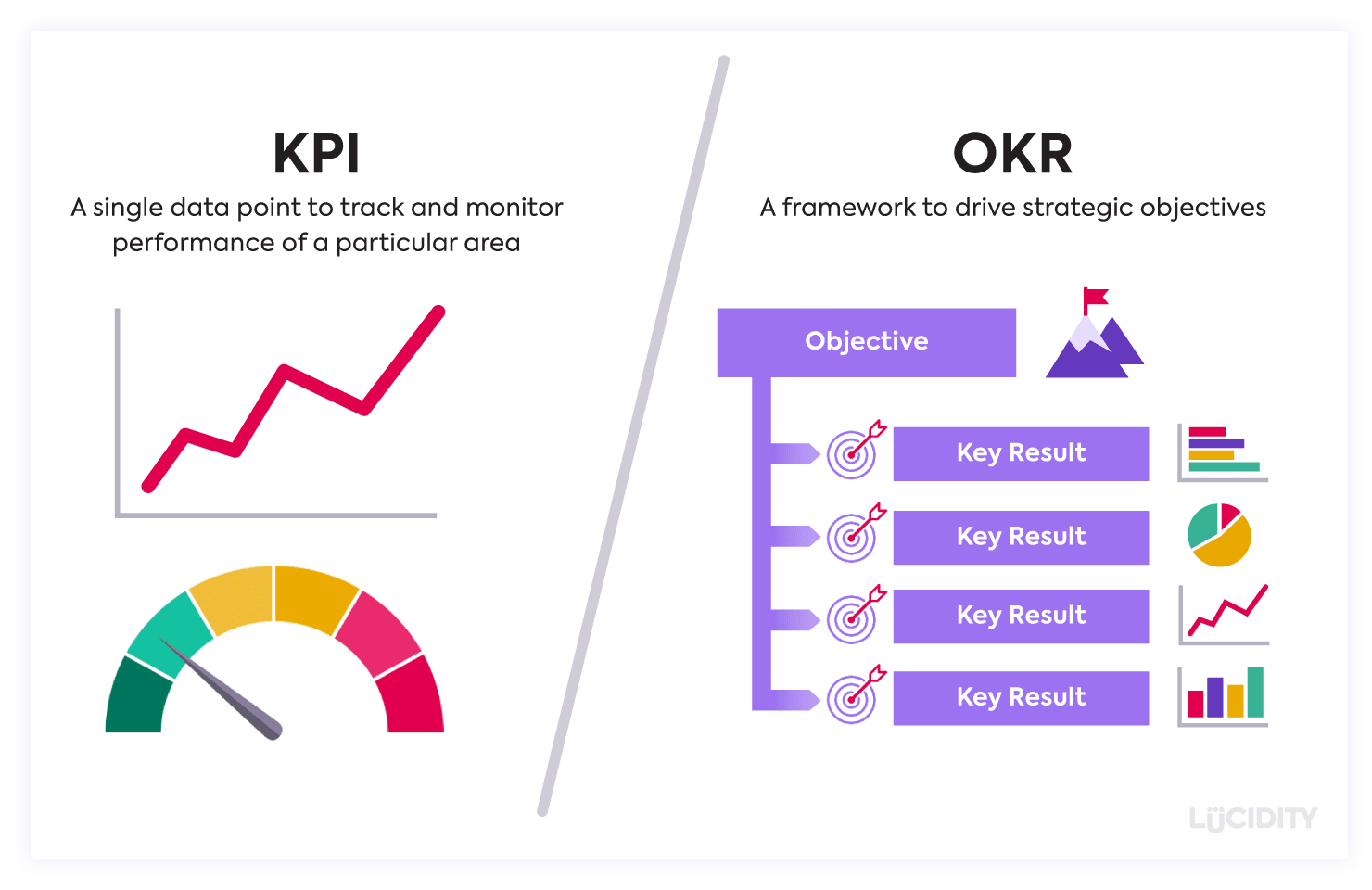If you are serious about achieving your business goals, driving growth and succeeding, you’ll need to have a well thought-through strategy, and then use a clear framework for setting targets and tracking performance. KPIs and OKRs are two examples of the different ways you can run and monitor the execution of your business strategy.
So, which of these should you use and why? KPIs or OKRs? And are they actually mutually exclusive or do they both have a role to play in your strategic execution?
In this article we’ll take a look at both, when each should be used and how they can work together.
We’ll cover…
What is a KPI?
KPI stands for key performance indicators which are metrics you set to monitor and assess the performance of a particular activity, department, product or service, initiative or company. These data points will be numbers, percentages, durations or ratios.
KPIs are often used as health metrics for a business. If not linked to specific strategic goals they are used to keep an eye on/monitor performance. As long as a KPI stays within a particular threshold then there is no reason for changes to be made or dramatic action to be taken. And that can be valuable, giving you a reassurance that things are being maintained. But when you’re considering KPIs under the umbrella of strategy, they need to be linked to specific strategy objectives and defined goals to help drive change, growth and innovation.
You see, the KPI is the metric you decide to track, but actually, there’s nothing in the concept of a KPI on it’s own that forces you to add a particular target for that metric. In order for KPIs to be truly valuable we would also urge you to assign a target to it so you know what good looks like. It’s no good just monitoring a metric if you haven’t decided what good performance looks like and what the target number is that you want to see. So always think of KPIs as a component of a wider structure that includes strategic objectives and measurable goals.
So KPIs are valuable when used as part of a strategic framework, whereas OKR is, to some extent, a strategic framework in its own right.
What is an OKR?
OKR stands for Objective and Key Results. OKRs are more explicitly linked to goal setting than KPIs. OKRs have two elements – an objective and then the key results.
The Objective in an OKR is like a strategic objective – it is one of the limited number of key things you want to achieve as a business in order to meet your overall vision.
The Key Results in an OKR are the specific targets that need to be hit in order for you to achieve that Objective. These are the steps you need to take and the results you’ll need to see to achieve that aim.
Whereas KPIs tend to focus on monitoring your existing activity, OKRs might be focused on driving new initiatives and hitting new strategic objectives. Where the former is more ongoing, the latter is more contextual, time-based and specific to a new focus for the business.
KPIs are more likely to be ongoing measurements spanning years, whereas OKRs might be relevant to a particular quarter or fiscal year. In fact, OKRs are most commonly used on a quarterly basis with different OKRs for each quarter.
A business looking to maintain an already-secured dominance in the market might opt for KPIs as their approach, and a business looking to make bold moves and big changes might prefer the more aggressive leaning of OKRs.
Businesses tend to use OKRs for big, ambitious plans. There’s a widely held belief that the objectives and key results you set with OKRs should be so ambitious that they’re bordering on impossible! The OKR ethos is about driving your teams forward to make big leaps, strive for significant growth and push their performance to the max.
Companies who use and evangelize the OKR framework include Google and Intel.
What Are Some Examples of KPIs?
Different areas of a business are likely to have very different KPIs, and different types of businesses may also have their own particular metrics that are important to track. Here are a few examples:
Marketing KPI examples
- Cost Per Lead
- Customer Acquisition Cost
- MQL to SQL Conversion
- Unique Users
- Average Order Value
Finance KPI examples
- Net Profit
- Operating Cash Flow
- Revenue
- Working Capital
- Return on Equity
People/HR KPI examples
- Retention Rate
- Time to Hire
- Absenteeism Rate
- Employee Net Promoter Score (eNPS)
- Diversity
To find more KPI examples, including Product KPIs, Customer KPIs and more, check out our Ultimate Guide to KPIs.
What Are Some Examples of OKRs?
Objective: Grow word of mouth marketing
Key Results:
- Decrease customer service response time by 50%
- Plan and roll-out new customer email marketing by end of quarter
- Increase NPS score by 50%
- Increase customer reviews on external review sites by 100 reviews
- Grow positive social mentions by 60%
Objective: Increase average order value of all ecommerce customers
Key Results:
- Introduce free shipping with minimum order value by end of quarter
- Increase upsell conversion in email marketing by 20%
- Increase number of product page cross sells by 50%
- Establish a customer loyalty scheme and secure 3000 members
- Increase use of first purchase discount by 40%
Objective: Create a workplace people love and increase employee retention
Key Results:
- Increase employee net promoter score to 35
- Get employee attendance of monthly social to 90%
- Put all managers through coaching training
- Increase training satisfaction score to 85%
- Increase average compa-ratio to 100%
Secrets to Using KPIs Well
- Don’t have too many – will lead to a lack of focus
- Don’t copy other people’s – just because it’s the right performance indicator for someone else’s business (even if they are a similar business), doesn’t mean it’s right for yours
- Pick your KPIs based on your strategic priorities – If you particularly want to increase customer satisfaction to help grow word of mouth, then make sure something like CSAT or a particular star rating on a review site is on your KPI lists. Similarly, if you’re strategically focused on growth and are investing to do that, then there’s no point listing profit as a KPI if you plan to invest in, say, marketing at the expense of profit for a period of time
- Have clear accountability and ownership of each KPI – know who is responsible for that metric
- Use a system to track – monitor all the top KPIs across the business centrally, ideally with a system that will automate that as much as possible – saves you time, ensures it actually happens, gives you fast an easy visibility of the performance of the whole business
- Associate your KPI with a specific strategic objective and goal so there is a clear target for that metric and a strong ‘why’ – what important business objective will this area of performance contribute to
OKR Best Practice
Think big – focus on growth, innovation, positive change and significant results. This is not the time to be cautious and sensible, you want to be setting bold and ambitious objectives here . If you’ve choosing to use the OKR framework then embrace it and GO BIG.
Just focus on what will truly make a difference – you want a focused list of a few OKRs so everyone has laser focus, distractions are minimized and you stand the best chance of getting the jobs done. Don’t try and cover everything each quarter. Remember, you can always save an objective for a future quarter.
Communicate your OKRs to the whole business – if you’ve gone big with your OKRs then they will be motivating for everyone to see. They will paint a picture of exciting growth and a successful future. Make sure everyone knows the big ambitions you have and it will help get your people into a bold, growth mindset.
Don’t expect to hit every key result. This seems like an odd thing to say, but OKRs are supposed to be high level and ambitious – really ambitious – so ambitious that they are extremely hard to actually hit. But that’s OK – you will be stretching yourselves, pushing your performance and achieving more as a result. If you find you are achieving all of your key results to the maximum then, potentially, your OKRs are not aggressive enough.
Can KPIs and OKRs Work Together?
KPIs are single data points, whereas OKRs will involve a few different data points with multiple key results per OKR. Therefore, OKRs and KPIs are not necessarily incompatible. You could use KPIs as your health measures across the business – a quick way to get reassurance and visibility on the performance of the business – but then also run OKRs focused on your growth activity and your future strategic ambitions.
The key results in your OKRs may link to your KPIs. So if you had a KPI of customer retention which you’d been carefully monitoring over the years, it might become linked to a Key Result when you set an Objective to significantly increase revenue from your existing customer base and have a Key Result under that of eliminating customer churn.
Your KPI is the metric, but the Key Result gives a particular target or goal to it.
For example, businesses who favour an OKR framework use Lucidity in just that way. Using the Strategy Tree, they create their Objectives, then attach a number of Key Results (Goals as they are labelled in the software) to each objective and input a specific measure and target. They can then associate any KPI from their KPI Tracker to that Goal/Key Result and the two will be linked. Whenever a synced KPI is automatically updated through say, an integration with the finance system, that goal will also be updated and the progress against target tracked in clear graphs.












